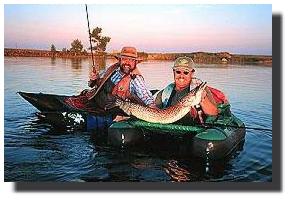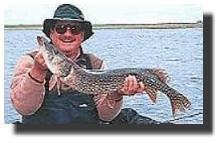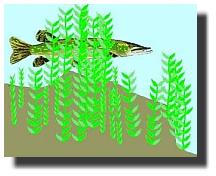Fly-fishing for Prairie Pike, Part 4
When and where to catch pike
By Clive Schaupmeyer
This the fourth of a series of five articles about fly-fishing
for pike. The articles include: introduction; equipment and rigging; flies
and other gear; when and where; and techniques.
Pike can be caught on a fly rod any time the water is free of ice. Generally
they are slow to bite during the spring breeding season (just after ice
out), then start feeding heavily right after the spawn. They seem to slow
down again as the water warms. The action varies with the season, but pike
can be caught for six or seven months of the year in most parts of Canada.

Pike move into ice-free shallow bays while the main part of a lake
is still frozen. They swirl and twist (in breeding mode) when there is
still floor ice in the bays and the water is ice cold. I've caught a few
pike during the height of the breeding season�but damn few. Streamers can
be stripped right in front of pike floating on the surface, but when they
have sex on their pea-sized brains they just aren't interested in eating.
By mid to late April, anglers around here start grumbling about the
pike being off�forgetting it's the same every year. We've gone out once
or twice and caught one pike�or none at all. We keep grumbling. Then at
the end of one sunny day in early May, my phone will ring in the evening.
It will be K.K., and the news will be: The pike fishing is hot! (Kiyoshi,
a.k.a. K.K., will have spent the afternoon catching pike.)

In southern Alberta the best pike action is in May through early June,
but they can be caught all summer as well. I've fished for pike in northern
Alberta and northern Saskatchewan a couple of times�once in early June
and once in mid July. The action was great in early June, just two weeks
after ice out. We caught our share of pike in July as well, but the lodge
owner said we had missed the peak feeding season.
Within the time window when pike fishing is generally hot, there will
be ups and downs in the action as pike moods change. Around here the pike
are most active (read, easiest to catch) during clear-sky, high-pressure
weather systems. Warm and sunny. Sure, they are catchable on cold, blustery
spring days, but the catch rates fall off drastically.
Where are pike likely to be? Pike are ambush feeders and live near,
on, over, beside or withinsomething like a weed bed, drop-off, reef, shallow
bay or stream flow. Most often they will be caught where there is some
noticeable structure or a change in water condition, such as clarity, temperature
or current. Food organisms that attract baitfish�which attract pike�live
in weed beds or may be carried in a slow current near an inlet or outlet.
When prairie winds roil the water in shallow bays, pike will hold just
inside or outside the murky water waiting for a meal to cruise by.

Where would you hide if you were a hungry pike waiting to ambush a
meal?
Quietly kick your float tube near an island or point, cast
to the shallow water, then control your retrieve so the fly drops down
as the water gets deeper. Or cast parallel to the drop-off and retrieve
at various depths. Hold over a shallow bar or weed bed and cast out to
deeper water, retrieving your fly so it travels up the slope or beside
the weeds. Cast a gaudy streamer into small open pockets along the edge
of a weed bed. Try casting into flowing water that could carry food, or
might be warmer or cooler than the surrounding water. If the water has
clear and murky sections, cast into or alongside the cloudy water and retrieve
your fly into or along the edge of the clear water.
Next week: Retrieval techniques and releasing pike.
~ Clive Schaupmeyer
Our Man In Canada Archives
|

 May 3rd, 1999
May 3rd, 1999


 May 3rd, 1999
May 3rd, 1999

